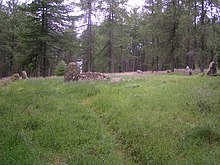Nine Stanes
Nine Stanes (also called "Garrol wood" or "Mulloch wood") belongs to the category in the UK " Recumbent Stone Circle called" (RSC) stone circles . A characteristic of the RSC is a "lying stone" accompanied by two standing, high, often tapering "flank stones" that are located within the circle or near the circle. Nine Stanes is in Kincardineshire , Scotland ; about 6.5 km southeast of Banchory near the road from Strachan to Blairydryne in a forest clearing.
Not to be confused with Ninestane Rig in Scotland or Nine Stones (Belstone) , Nine Stones (Winterbourne Abbas) or Nine Stones (Altarnun) in Cornwall .
The oval of the “nine stones” originally consisted of eight medium-sized menhirs , plus the ensemble of the so-called “resting stone” with its flank stones. In circles of this type, this group of three is usually located like an altar in the south-west on the arc of a circle.
description
The oval
The oval of Nine Stanes is 17.5 m long in west-east direction and 14.5 m wide in north-south direction. This corresponds to a circumference of around 50 m. The stones are spaced 3.5 and 5.5 m apart. The wide gaps are filled with stone fragments arranged on the oval. The stones, which are set about 40 cm into the ground, are graded in height on the eastern side - unlike on the western side. The “resting stone” is closest to the center, is made of diorite and weighs over 16 tons. The other stones are made of red granite . In the west arch one stone is missing today, another has been reduced to a stump. A stone 25 m outside the oval in the northeast is perhaps a so-called outlier. There may have been another, but now offset, stone that appears to have been to the southeast. Stones in this position may have been used as bearing stones.
The Ringcairn
Later, a 0.3 m high slightly non-circular annular been Cairn of quarry stone set in the stone oval. The diameter of its heavily disturbed edge formed by boulders is about twelve meters. On the south side it touches the resting stone. Six dumps were found in the central recess of the cairn, which was about four meters wide and reached to the ground. A blunt funnel-shaped pit. The upper diameter was 60-70 cm and 10 cm at the base 25 cm lower. It was filled to the brim with charcoal and corpse burn. Four more with corpse burn and one with charcoal mixed with ceramics were found around the funnel-shaped pit. Differences in the ritual were observed here. The north-western bone bed lay on a small, thick granite slab, whereas the bones on the opposite side were laid in cavities without stone support or stone protection. The (yellow) open space between the cairn and the oval was divided into six parts, which may have been intended for further burials, but no evidence of this was found.
interpretation
When Frederick Rhenius Coles (1854–1929) was digging at the Nine Stanes in 1904, it took his helpers twelve days to clear the undergrowth above the stones. He was more careful than most archaeologists of the time and made a map of the features that had become visible. Before starting the dig, he divided the circle into digging sections. He uses a land surveyor's leveling device. He sifted the previously dried earth from the central area of the cairn. But he was still unable to answer questions about the time between the erection of the oval and the ringcairn. Comparing Nine Stanes to similar sites recently excavated revealed clues to fill this knowledge gap.
The stone circles on the River Dee
The Deeside Stone Circles form a group of Recumbent Stone Circle (RSC). About 100 of them were born between 2500 and 1500 BC. In Aberdeenshire. The ensembles of the "resting stones" are usually in the southeast and (usually) on the course of the ring. Nine Stanes seems to have been erected later than these circles because it forms a flat oval, the stones of which have not been stepped in height.
literature
- Aubrey Burl: The Stone Circles of the British Isles . Yale University Press, New Haven CT et al. 1976, ISBN 0-300-01972-6 .
- Anna Ritchie: Scotland BC. An introduction to the prehistoric houses, tombs, ceremonial monuments and fortifications in the care of the Secretary of State for Scotland . Scottish Development Dept., Edinburgh 1989, ISBN 0-11-493427-4 .
- Ian AG Shepherd: Exploring Scotland's Heritage. Grampian . HMSO, Edinburgh 1986, ISBN 0-11-492453-8 .
- Ian AG Shepherd: The early people . In: Donald Omand (Ed.): The Grampian Book . Northern Times, Golspie 1987, ISBN 0-9501718-8-3 .
Web links
Coordinates: 57 ° 0 ′ 40.5 " N , 2 ° 27 ′ 25.8" W.

